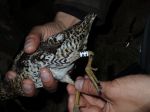Great Snipe studies underway
12 czerwiec 2013
 So far, the research has taken place at one fixed and two satellite leks in the upper part of the Narew River Valley. The prolonged presence of the high water level in the area meant that we are observing a lot of displacements and even the disappearance (although probably temporary) of many known leks. So far we have been able to capture a total of 19 individuals. We have deployed 14 VHF transmitters and 5 with GPS loggers.
So far, the research has taken place at one fixed and two satellite leks in the upper part of the Narew River Valley. The prolonged presence of the high water level in the area meant that we are observing a lot of displacements and even the disappearance (although probably temporary) of many known leks. So far we have been able to capture a total of 19 individuals. We have deployed 14 VHF transmitters and 5 with GPS loggers.
In case of the VHF telemetry, birds tracking is undertaken using special directional antennas that can locate individuals up to about 1 km. It is a labour-intensive method and requires following the tracked individual to its current location through usually very difficult conditions. It however, allows us to find nests and measure the habitat parameters in micro scale.
With the use of the GPS technology, the location of the bird is recorded automatically, and then sent to the receiving station, which is located permanently at one of the lek. Every day, we record movements of individual birds and their attendance at the leks. At the locations where great snipes are frequently present, we define a number of parameters of the habitat, such as soil permeability, vegetation cover and its height, pH, electrolytic conductivity and the presence of invertebrates in soil samples. Thanks to these data, we will learn which habitat conditions are preferred by great snipes in the Upper Narew River Valley. By applying an innovative for this species GPS loggers, we already know that the birds come back immediately after releasing to the lekking site and remain in their territories. We also found a couple of nests of great snipe, which have been carefully described and protected from accidental damage while conducting research. We look forward to hatching of the first great snipe, which should appear in one of the monitored nests any day now.
Michal Korniluk






